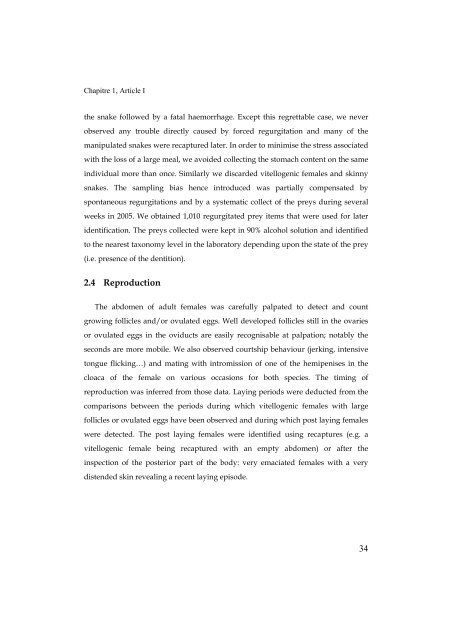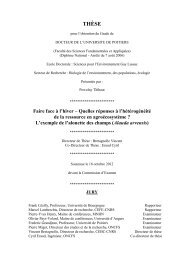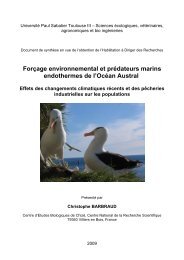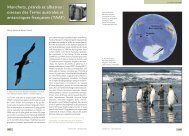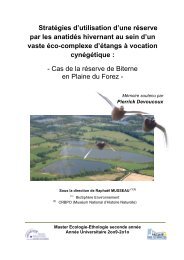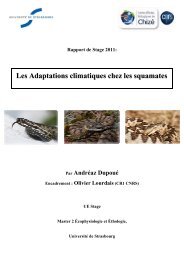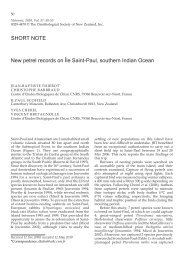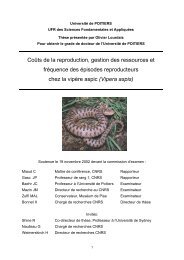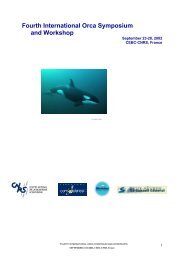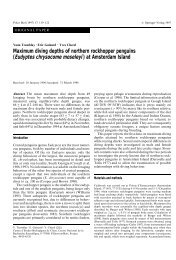- Page 1 and 2: Université FRANÇOIS RABELAIS, TOU
- Page 3 and 4: Remerciements Aussi évident que ce
- Page 5 and 6: Pour l’aide permanente qui permet
- Page 7 and 8: Pour l’aide indispensable, sans l
- Page 9 and 10: I- INTRODUCTION Table des matières
- Page 11 and 12: Are sea snakes pertinent bio-indica
- Page 13 and 14: INTRODUCTION 1
- Page 15 and 16: coexistence et leur compréhension
- Page 17 and 18: Mais la taille corporelle influence
- Page 19 and 20: Structure de la thèse Quels que so
- Page 21 and 22: adéquates pour accomplir des activ
- Page 23 and 24: chaque article. Ainsi, cette partie
- Page 25 and 26: Modèles d’étude Position taxono
- Page 27 and 28: Le complexe L. colubrina Laticauda
- Page 29 and 30: Sites d’étude La Nouvelle-Caléd
- Page 31 and 32: FIG. 5 - Pictures of some of the st
- Page 33 and 34: TABLEAU 1 - Details of the differen
- Page 35 and 36: entraînant une hémorragie fatale.
- Page 37 and 38: Récapitulatif Nous avons observé
- Page 39 and 40: Life history of sea kraits in New C
- Page 41 and 42: 1 INTRODUCTION Mémoires du Museum
- Page 43 and 44: 2 MATERIAL AND METHODS 2.1 Study si
- Page 45: Mémoires du Museum National d’Hi
- Page 49 and 50: Mémoires du Museum National d’Hi
- Page 51 and 52: Mémoires du Museum National d’Hi
- Page 53 and 54: Mémoires du Museum National d’Hi
- Page 55 and 56: 3.4 Reproduction Mémoires du Museu
- Page 57 and 58: Mémoires du Museum National d’Hi
- Page 59 and 60: Clutch size 9 8 7 6 5 4 3 2 1 Mémo
- Page 61 and 62: Mémoires du Museum National d’Hi
- Page 63 and 64: Mémoires du Museum National d’Hi
- Page 65 and 66: Mémoires du Museum National d’Hi
- Page 67 and 68: Mémoires du Museum National d’Hi
- Page 69 and 70: Résumé du Chapitre Ce chapitre es
- Page 71 and 72: COMPORTEMENT DE PLONGÉE 59
- Page 73 and 74: Proceedings of the 11 th Annual Mee
- Page 75 and 76: Proceedings of the 11 th Annual Mee
- Page 77 and 78: Proceedings of the 11 th Annual Mee
- Page 79 and 80: 2.3 Surgery Proceedings of the 11 t
- Page 81 and 82: Proceedings of the 11 th Annual Mee
- Page 83 and 84: Proceedings of the 11 th Annual Mee
- Page 85 and 86: Temperature (°C) 28 27 26 25 24 23
- Page 87 and 88: Log 10 diving maximum duration (min
- Page 89 and 90: Proceedings of the 11 th Annual Mee
- Page 91 and 92: Proceedings of the 11 th Annual Mee
- Page 93 and 94: A method to reconstruct anguillifor
- Page 95 and 96: 1 INTRODUCTION Marine Biology 151:1
- Page 97 and 98:
Marine Biology 151:1893-1897 The pr
- Page 99 and 100:
3 Results 3.1 Estimating the length
- Page 101 and 102:
Marine Biology 151:1893-1897 signif
- Page 103 and 104:
Marine Biology 151:1893-1897 APPEND
- Page 105 and 106:
Marine Ecology Progress Series 350:
- Page 107 and 108:
Marine Ecology Progress Series 350:
- Page 109 and 110:
2 MATERIAL AND METHODS 2.1 Study sp
- Page 111 and 112:
3 Results 3.1 Composition of diet M
- Page 113 and 114:
3.2 Prey habitat Marine Ecology Pro
- Page 115 and 116:
Marine Ecology Progress Series 350:
- Page 117 and 118:
Marine Ecology Progress Series 350:
- Page 119 and 120:
Marine Ecology Progress Series 350:
- Page 121 and 122:
Submitted to Marine Ecology Progres
- Page 123 and 124:
Submitted to Marine Ecology Progres
- Page 125 and 126:
Submitted to Marine Ecology Progres
- Page 127 and 128:
Submitted to Marine Ecology Progres
- Page 129 and 130:
Submitted to Marine Ecology Progres
- Page 131 and 132:
Prey size (diameter mm) 35 30 25 20
- Page 133 and 134:
Submitted to Marine Ecology Progres
- Page 135 and 136:
LES TRICOTS RAYÉS COMME BIO-INDICA
- Page 137 and 138:
Marine Biology 151:793-802 Abstract
- Page 139 and 140:
Marine Biology 151:793-802 The dens
- Page 141 and 142:
Marine Biology 151:793-802 helped b
- Page 143 and 144:
Marine Biology 151:793-802 digested
- Page 145 and 146:
Marine Biology 151:793-802 TABLE 3
- Page 147 and 148:
Marine Biology 151:793-802 Thus, UV
- Page 149 and 150:
Marine Biology 151:793-802 sample o
- Page 151 and 152:
Marine Biology 151:793-802 trips ar
- Page 153 and 154:
Marine Biology 151:793-802 small is
- Page 155 and 156:
Cybium, in press RÉSUMÉ. - Plusie
- Page 157 and 158:
Cybium, in press for later identifi
- Page 159 and 160:
Cybium, in press The diagnostic cha
- Page 161 and 162:
1 INTRODUCTION Manuscript in prepar
- Page 163 and 164:
Manuscript in preparation compariso
- Page 165 and 166:
Manuscript in preparation the 49 ee
- Page 167 and 168:
3 Results 3.1 Analyses of similarit
- Page 169 and 170:
Manuscript in preparation For L. la
- Page 171 and 172:
Manuscript in preparation Such esti
- Page 173 and 174:
Résumé du Chapitre Ce chapitre es
- Page 175 and 176:
Chapitre III ECOLOGIE TERRESTRE DES
- Page 177 and 178:
Precise site fidelity in sea kraits
- Page 179 and 180:
Manuscript in preparation this stud
- Page 181 and 182:
Mean distance between captures (m)
- Page 183 and 184:
LA SELECTION DE L’HABITAT 171
- Page 185 and 186:
Manuscript in preparation Abstract.
- Page 187 and 188:
Manuscript in preparation identifie
- Page 189 and 190:
Manuscript in preparation (Ineich e
- Page 191 and 192:
2.4 Study zones Manuscript in prepa
- Page 193 and 194:
Manuscript in preparation FIG. 2 -
- Page 195 and 196:
Manuscript in preparation 2.6 Popul
- Page 197 and 198:
Manuscript in preparation Overall,
- Page 199 and 200:
Segments 5 10 15 20 25 30 35 40 Num
- Page 201 and 202:
Manuscript in preparation We observ
- Page 203 and 204:
Manuscript in preparation As a cons
- Page 205 and 206:
Temperature (°C) 60 50 40 30 20 38
- Page 207 and 208:
Manuscript in preparation during th
- Page 209 and 210:
Manuscript in preparation acquired
- Page 211 and 212:
Manuscript in preparation negative
- Page 213 and 214:
Manuscript in preparation attention
- Page 215 and 216:
Thirsty sea snakes forsake their sh
- Page 217 and 218:
1 INTRODUCTION Manuscript in prepar
- Page 219 and 220:
Manuscript in preparation Sea krait
- Page 221 and 222:
Manuscript in preparation behaviour
- Page 223 and 224:
Manuscript in preparation The two s
- Page 225 and 226:
Manuscript in preparation rocks. In
- Page 227 and 228:
Number of snakes observed per minut
- Page 229 and 230:
Manuscript in preparation Furthermo
- Page 231 and 232:
Drinking posture Top Ground Time Ma
- Page 233 and 234:
Manuscript in preparation dry and c
- Page 235 and 236:
Résumé du Chapitre Si la vie aqua
- Page 237 and 238:
SYNTHÈSE ET CONCLUSIONS 225
- Page 239 and 240:
font preuve d’une endurance extr
- Page 241 and 242:
deux particularités indispensables
- Page 243 and 244:
diversité spécifique plus grande
- Page 245 and 246:
des rochers. Ces rochers sont préc
- Page 247 and 248:
est évident que la disparition de
- Page 249 and 250:
marine pourraient vraisemblablement
- Page 251 and 252:
Bennett JM, Taplin LE, Grigg GC. 19
- Page 253 and 254:
Journal of Experimental Biology 203
- Page 255 and 256:
Ineich I, Bonnet X, Brischoux F, Ku
- Page 257 and 258:
of eels (Muraenidae, Congridae) in
- Page 259 and 260:
Starin ED. 2002. Drinking observati
- Page 261 and 262:
Allometry of diving capacities: ect
- Page 263 and 264:
1 INTRODUCTION Journal of Evolution
- Page 265 and 266:
Journal of Evolutionary Biology 21:
- Page 267 and 268:
Journal of Evolutionary Biology 21:
- Page 269 and 270:
Journal of Evolutionary Biology 21:
- Page 271 and 272:
Journal of Evolutionary Biology 21:
- Page 273 and 274:
Journal of Evolutionary Biology 21:
- Page 275 and 276:
Online appendix List of the familie
- Page 277 and 278:
Journal of Evolutionary Biology 21:
- Page 279 and 280:
Journal of Evolutionary Biology 21:
- Page 281 and 282:
Population Ecology, submitted Abstr
- Page 283 and 284:
Population Ecology, submitted vario
- Page 285 and 286:
Population Ecology, submitted speci
- Page 287 and 288:
Population Ecology, submitted Prey
- Page 289 and 290:
References Population Ecology, subm
- Page 291 and 292:
Is melanism adaptive in sea kraits?
- Page 293 and 294:
1 INTRODUCTION Amphibia-Reptilia, i
- Page 295 and 296:
Amphibia-Reptilia, in press (either
- Page 297 and 298:
Amphibia-Reptilia, in press melanic
- Page 299 and 300:
Amphibia-Reptilia, in press explana
- Page 301 and 302:
Amphibia-Reptilia, in press Johnsen
- Page 303 and 304:
Annexe IV Herpetological Review, in
- Page 305 and 306:
Annexe V 293
- Page 307 and 308:
Annexe V 295
- Page 309 and 310:
Annexe V 297
- Page 311:
Annexe VI Autres publications Ford


